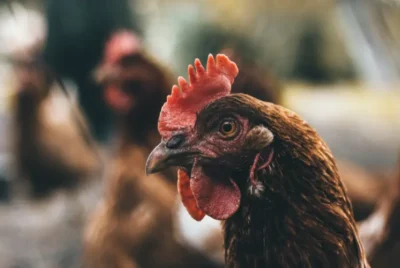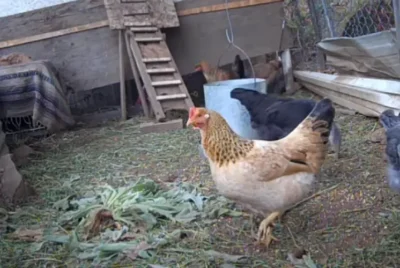Safe Broody Breaker Methods: How to Break a Broody Hen
Have you ever faced the frustration of having a broody hen who refuses to leave her nest, disrupting your flock’s harmony and egg production? Broody behavior in hens, while natural, can be a real pain point for poultry enthusiasts. It can lead to potential health issues for the brooding hen, and even conflict within the flock.
The good news is that there are effective and safe broody breaker methods to help you overcome this challenge and restore peace to your chicken coop. In this guide, we’ll delve into these methods, providing you with practical solutions to stop broody behavior in hens and maintain a harmonious and productive poultry environment.
What Does It Mean When a Hen Is Broody?
When a hen is broody, she desires to hatch eggs and care for chicks. This behavior is completely natural and instinctual for hens, although some breeds are more prone to it than others.
Broodiness usually kicks in during the spring when the weather gets warmer and the days become longer, which triggers hormonal changes in the hen, prompting her to go into broody mode. It’s her way of getting ready to be a devoted mother and raise the next generation of chickens.

8 Safest Ways To Stop A Broody Hen
1. Take Your Hen Away from Her Nest
One of the most straightforward and effective broody breaker methods to address broodiness is to take the hen away from her nest. Broody hens are often fixated on their nesting area, so by removing them from it, you can disrupt their routine.
Place the broody hen in a separate enclosure with food, water, and a comfortable roosting spot. This isolation period should help break the broody cycle.
2. Block Access to the Nest Box
Another safe and practical method is to block the broody hen’s access to the nest box. This strategy can be used in conjunction with taking her away from her nest. After you’ve removed her, close off or block the entrance to the nest box.
Ensure that other hens can’t access it either. This way, the broody hen won’t have the opportunity to continue her brooding.
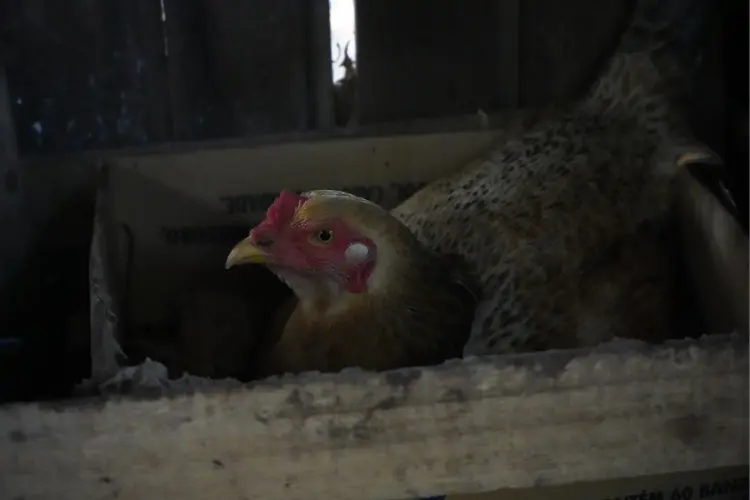
3. Provide Distractions for Your Broody Hen
Broody hens often become singularly focused on nesting and hatching eggs. To redirect their attention, provide distractions. Offer treats like mealworms or fresh vegetables. Hanging a head of cabbage or a corn cob can also give them something to peck at and explore.
Encourage outdoor activities by allowing them to free-range, which can break the monotony of their broody behavior.
You can also read my picks for the best toys for chickens to help you entertain your hens.
4. Place a Chilled Water Bottle in the Nesting Area
Lowering the broody hen’s body temperature can be a gentle way to discourage her broodiness. To achieve this, place a chilled water bottle or ice pack in the nesting area where she prefers to sit.
The cold surface can help reduce her body temperature, making her less inclined to brood. Be sure to use a durable container to prevent her from pecking at it.
5. Offer Your Hen a Refreshing Bath with Cool Water
A cooling bath can be a soothing experience for a broody hen. Fill a shallow basin with cool water and gently place the hen in it. Ensure that the water is not too cold, as you don’t want to shock or distress her.
Keep her in the bath for a few minutes, allowing her belly and chest to make contact with the water. This can help lower her body temperature, making her less inclined to brood.
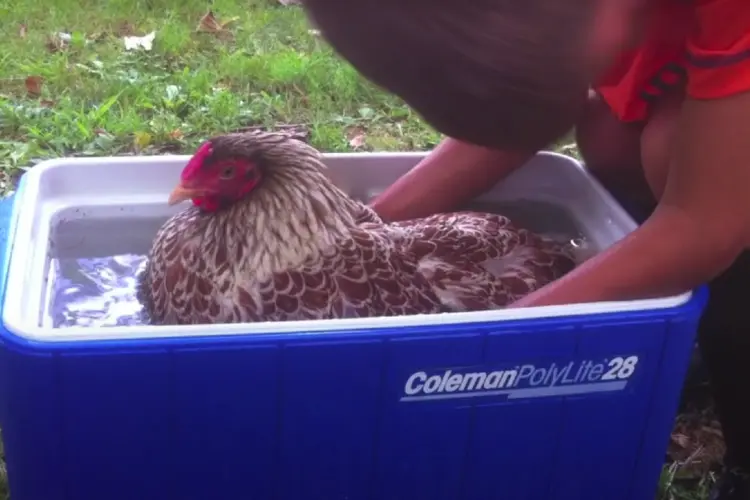
6. Clear Out Any Bedding or Any Nesting Material
Broody hens often prepare cozy nests with bedding and nesting material. To discourage broodiness, remove all bedding and nesting materials from the nest box or preferred nesting area. Without the comfortable nest, she may be less inclined to sit for extended periods.
7. Limit Your Hen Entry to the Coop
Restricting your broody hen’s access to the coop during the day or chicken jail can help break her broody cycle. Encourage her to spend more time outdoors by limiting her coop time. This change of environment can divert her focus away from nesting.
8. Carry Your Hen Around
Prying the broody hen out of her nesting box and carrying her around for a while can be an effective way to interrupt her brooding. This allows cool air to flow under her feathers and onto her breast, further helping to lower her body temperature.
Be gentle and patient as you carry her, and ensure she has a chance to stretch her legs and experience a change of scenery.
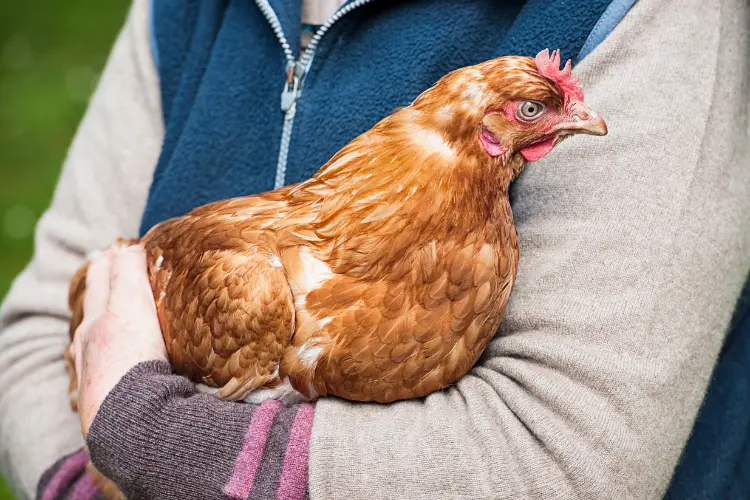
What Leads to Broodiness?
- Increasing Daylight Hours– As spring approaches and the days get longer, the increased exposure to daylight triggers hormonal changes in the hen’s body. Longer daylight hours stimulate the release of hormones like prolactin from the pituitary gland, which is crucial in initiating broodiness.
- Hormonal Changes– Prolactin is a key hormone responsible for broodiness. When its levels rise in response to longer daylight hours, it prompts the hen to become broody.
- Nest Availability– Hens often become broody when they can access a suitable nest and a clutch of eggs to incubate. A comfortable, secluded nest with a few eggs (either her own or those of other hens) can encourage broodiness.
- Age and Breed– Some chicken breeds are more genetically predisposed to broodiness than others. Additionally, older hens are more likely to go broody than younger ones.
- Individual Variation– Broodiness can also vary among individual hens. Not all hens within the same breed and age group will necessarily become broody at the same time or to the same degree.
- Lots of Eggs in the Nest Box– Providing a nest box with a substantial number of eggs can encourage broody behavior, as hens may see the opportunity to incubate and hatch a clutch of eggs.
- Warm Weather– While it’s not a direct cause, broodiness often coincides with warmer springtime weather when hens are more inclined to sit on all the eggs and raise chicks.
Which Chicken Breeds Are Prone to Broodiness?
- Silkie– Silkie chickens are renowned for their strong brooding instincts. They make excellent mothers and are known for their gentle and maternal nature.
- Cochin- Cochins are large, fluffy chickens that tend to go broody frequently. They are known for their dedication to nesting and caring for chicks.
- Orpington– Orpington chickens, particularly the Buff Orpington variety, are known for being broody and excellent mothers. They are calm and friendly birds.
- Brahma- Brahmas are another large, docile breed that frequently goes broody. They are known for their gentle temperament and motherly instincts.
- Australorp- Australorps have a reputation for going broody and being attentive mothers. They are also excellent egg layers.
- D’Uccle– Belgian d’Uccle chickens, especially the Mille Fleur variety, are often broody and make good mothers. They are small and have distinctive feather patterns.
- Sussex– Sussex chickens are known for their broody behavior and maternal instincts. They are also good layers of large, brown eggs.
- Plymouth Rock– Plymouth Rock, or Barred Rock, hens can be broody and make good mothers. They are friendly and easy to manage.
- Sebright- Sebrights are a bantam breed that can go broody and make attentive mothers despite their small size.
- Wyandotte– Wyandotte chickens are known for occasionally going broody and being protective mothers. They come in various color varieties like the lavender wyandotte.
How Can You Identify If a Hen Is Showing Broody Behavior
Identifying broody behavior in a hen involves observing her actions and demeanor. Here are some key indicators that can help you identify if a hen is displaying broody behavior-
- Nesting Boxes Occupation– Broody hens spend an unusually long time in the nesting box, often staying there for most of the day and night. They are committed to sitting on the eggs.
- Nesting Posture– Inside the nesting box, broody hens adopt a characteristic posture. They lie flat on the nest, with their body spread out, almost as if they are trying to hide the eggs. Their wings may be slightly spread to cover the eggs better.
- Protectiveness– Broody hens can become protective and defensive of their nesting area. They may puff out their feathers, emit warning sounds, or even peck at intruders (including your hand) that come near the nesting box.
- Persistent Nesting– If you remove a broody hen from the nesting box, she will often return to the box promptly, showing her strong commitment to incubating the eggs.
- Frequent Nest Visits– Broody hens will frequently visit the nesting box throughout the day, demonstrating their eagerness to remain with the eggs.
- Reluctance to Leave the Nest– Broody hens are reluctant to leave the nest for extended periods. They may only leave once a day to eat, drink, and defecate.
- Feather Plucking– Some broody hens may pluck their breast feathers to line the nest, creating a warm and comfortable environment for the eggs.
- Distinctive Smell– Broody hens may have a noticeable change in the smell of their waste due to holding it for longer periods while incubating. It can become rancid.
- Dedication to Eggs– If you provide a broody hen with a clutch of eggs (either her own or those from other hens), she will diligently sit on them and turn them regularly, indicating her commitment to hatching and caring for the eggs.
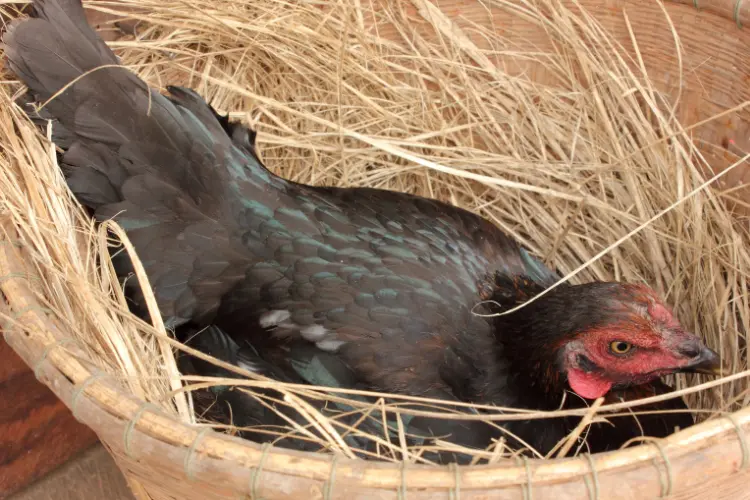
Why and When You Should Interrupt a Broody Hen?
Interrupting a broody hen’s behavior may be necessary for several reasons, and the timing depends on specific circumstances. Here are some common reasons and instances when you should consider interrupting a broody hen-
- Lack of Eggs or Chicks– If you don’t have fertilized eggs or chicks for the broody hen to care for, it’s best to interrupt her broodiness. Sitting on an empty nest can lead to wasted time and decreased overall health for the hen.
- Seasonal Inappropriateness– Broody behavior at certain times of the year may not be ideal. For example, if a hen goes broody during extreme heat, she can risk overheating and dehydration. Similarly, broodiness during the winter can be challenging, as hatching and raising baby chicks in cold weather can be difficult.
- Disruption to Egg Production– A broody hen’s presence in the nesting box can disrupt egg-laying and lead to fewer eggs for collection. If egg production is a priority, interrupting her broodiness may be necessary because broody hens will not lay eggs.
- Health Concerns– Broody hens may neglect their own health, as they tend to spend extended periods on the nest without eating, drinking, or caring for themselves. This can result in weight loss, dehydration, and poor overall health.
- Fecal Accumulation– Some broody hens may defecate in the nesting box, leading to unsanitary conditions that can affect egg quality and chick health if she were to hatch chicks.
- Contagious Behavior- Broodiness can be contagious among a flock. If one mama hen goes broody and others follow suit, it can disrupt flock dynamics and overall management.
- Not Fertile Eggs– If the eggs she’s sitting on are not fertile, or if you have no rooster for fertilization, there’s no reason to allow her to continue brooding.
- Other Flock Needs– Broody hens may not integrate well with the rest of the flock while they are focused on brooding. Interrupting broodiness can help maintain harmony in the flock.
The decision to interrupt a broody hen should consider both the well-being of the hen and the practicality of your chicken management goals, such as egg production and flock dynamics.
How to Determine When the Hen Is No Longer Broody
You can easily determine when a hen is no longer broody by observing her behavior. When she’s done with her broody phase, you’ll notice significant changes in how she acts.
A broody hen spends most of her time sitting on the nest, but when she’s no longer broody, she will willingly leave the nest and engage in her usual activities.
Broody hens tend to eat and drink very little, so when they’re no longer broody, they’ll start eating and drinking more regularly, which is a positive sign of recovery.
Additionally, broody hens can be quite defensive and may peck or screech when you approach the nest, but as they transition out of broodiness, they become less protective and more relaxed.
They’ll also return to roosting on perches with the rest of the flock at night instead of sleeping in the nest box.
Lastly, broody hens tend to isolate themselves from the flock, but when they’re no longer broody, they will rejoin the group and interact with other hens.
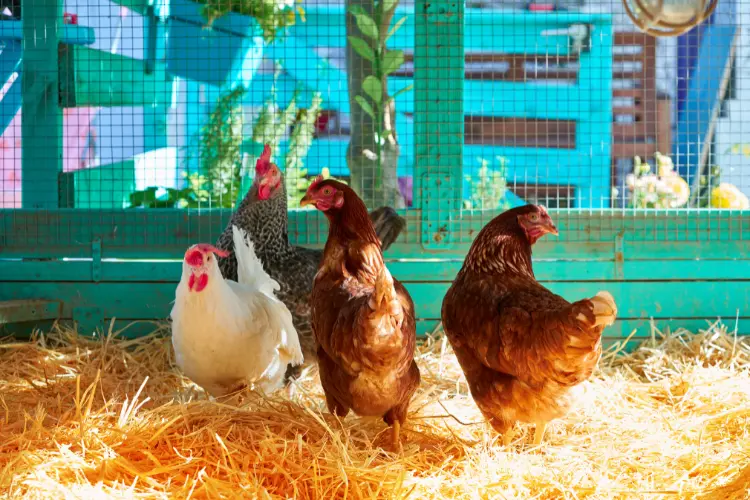
How to Break a Broody Hen Conclusion
Understanding and applying broody breaker methods are essential skills for chicken keepers. Broody behavior, while natural, can sometimes be inconvenient or even detrimental to a hen’s health.
By utilizing gentle and safe broody breaker methods like those I discussed, you can effectively encourage your broody hens to return to their normal routines.
Patience and consistent monitoring are key factors in successfully breaking broody chicken behavior, ensuring that both the hen and the flock remain healthy and harmonious.
For more valuable tips and insights into chicken raising, visit our website and become a pro at chicken raising!


